Weekly NHS Test and Trace bulletin, England: 16 July to 22 July 2020
Updated 3 August 2020
The data in the tables below reflect the first 8 weeks of operation of NHS Test and Trace.
For testing, they include:
- people tested for coronavirus (COVID-19)
- people testing positive for coronavirus (COVID-19)
- time taken for test results to become available
For contact tracing, they include:
- people transferred to the contact-tracing system, and the time taken for them to be reached
- close contacts identified for complex and non-complex cases, and the time taken for them to be reached
The purpose of this data is to provide a weekly update on the implementation and performance of NHS Test and Trace. Data collected for the test and trace programme is primarily for operational purposes and was not designed to track the spread of the virus. Studies into the spread of the virus in the UK are carried out by the Office for National Statistics (ONS). A list of data sources relating to the coronavirus pandemic in the UK can be found at Coronavirus (COVID-19) statistics and analysis.
A full explanation of the data sources and methods used to produce these statistics can be found in the methodology document.
Main points
NHS test and trace went live on 28 May.
In week 8 of contact tracing (16 to 22 July):
- 366,397 people were newly tested[footnote 1] for coronavirus (COVID-19) under pillar 1 (testing in hospitals and outbreak locations) and pillar 2 (national swab testing) in England
- around half of people (50.6%) tested under pillar 2 received the result within 24 hours of taking a test. This increases to over 3 out of 4 (76.4%) for tests that were carried out in person
- test results for 91.0% of people tested under pillar 1 were made available within 24 hours of the laboratory receiving the test for processing, increasing from 87.4% in week 7 (9 to 15 July)
- 4,128 new people tested positive for COVID-19
- 4,242 people had their case transferred to the contact-tracing system, from which 3,455 people (81.4%) were reached and asked to provide details of close contacts, increasing from 80.5% in week 7
- most people reached by NHS Test and Trace provided details for one or more contacts and this has increased to 81.3% from 79.2% in week 7
- 18,598 people were identified as coming into close contact with someone who has tested positive and been transferred to contact tracing. Of these, 13,974 people (75.1%) were reached and asked to self-isolate, a decrease from 78.4% in week 7
- of those contacts reached, 81.7% were reached within 24 hours after being identified as a close contact. 54.7% were contacted within 24 hours of the positive individual that reports them being transferred to contact tracing
- 63.2% of close contacts reported to NHS Test and Trace are within the same household as the positive case transferred, down from 69.0% in week 7
In total, since Test and Trace began (28 May 2020):
- 2,695,197 people were newly tested under pillars 1 and 2
- 42,964 new people have tested positive for COVID-19
- 43,119 people had their case transferred to the contact-tracing system[footnote 2], of whom 33,472 (77.6%) were reached and asked to provide details of their recent close contacts
- 222,589 people were identified as coming into close contact with someone who has tested positive. Of these, 184,703 (83.0%) were reached and asked to self-isolate
Terminology
People in England who have a positive coronavirus (COVID-19) test are transferred to NHS Test and Trace. Most of these people are tested under pillar 1 or pillar 2 of the government testing strategy:[footnote 3]
- pillar 1: swab testing in Public Health England (PHE) labs and NHS hospitals for those with a clinical need, and health and care workers
- pillar 2: swab testing for the wider population, through commercial partnerships[footnote 4]
Pillar 1 testing is conducted in hospitals and at outbreak locations.
Pillar 2 testing can be carried out through several different routes:
- regional test sites, which include drive-through testing centres with limited walk-up facilities. They also include local test sites, which are similar to regional test sites but specifically for walk-ups
- mobile testing units, which travel around the UK to increase access to COVID-19 testing. They respond to need, travelling to test people at specific sites including care homes, police stations and prisons
- satellite test centres, which includes test kits provided directly to ‘satellite’ centres at places like hospitals or care homes that have a particularly urgent or significant need
- home test kits, which are delivered to someone’s door so they can test themselves and their family without leaving the house
People tested refers to people who have newly been tested for COVID-19 and does not re-count people who have been tested more than once in either pillar 1 or pillar 2. People testing positive refers only to people who have newly tested positive for COVID-19 and does not include people who have had more than one positive test.
NHS Test and Trace has 2 ways of handling cases depending on their complexity:
-
PHE local health protection teams, to manage complex cases linked to outbreaks (referred to as complex cases here). Examples include someone who works or has recently visited:
- a health or care setting, such as a hospital or care home
- a prison or other secure setting
- a school for people with special needs
- critical national infrastructure or areas vital for national security
- wider online and other call centre capacity for less complex cases (referred to as non-complex cases here)
More details can be found in the methodology document.
Figure 1: flowchart showing how people move through the NHS Test and Trace service

Flowchart is explained in the document text.
Revisions for the week 7 publication from 9 July to 15 July
Figures for people testing positive for coronavirus (COVID-19) in previous releases have been revised. These revisions are because:
- there are sometimes delays in laboratories submitting data to PHE
- quality checks are conducted on the data to refine figures over time
Figures for pillar 2 testing turnaround times in the previous release have been revised. These revisions are because there have been improvements in the number of tests that have information about the lab in which the test was processed, including historic data. This means that more tests which previously could not be allocated to a nation have now been assigned as taking place in England. These updates have mainly affected home testing kits and satellite testing, as the location of the lab that processes the test is used to assign the location of the person being tested.
Figures for contact tracing in previous releases have been revised. These revisions are because the figures presented are based on a data cut several days after the end of the reporting period, to give time for cases reported towards the end of the 7-day period to have an outcome. Some cases may continue to be in progress after this period, and therefore data may need to be revised over time. The methodology document. gives more detail about this).
Testing
During week 8 of NHS Test and Trace (16 to 22 July) 366,397 people were newly tested for coronavirus (COVID-19). 4,128 new people had a positive result, an increase of 3% from week 7 (9 to 15 July)
Since Test and Trace launched:
- 2,695,197 people have been tested of which 64.2% were tested under pillar 2 and 35.8% under pillar 1. In week 8, there has been an increase of 44% in the number of people tested under pillar 2 since week 4 (18 to 24 June). This is in comparison to people tested under pillar 1, which has remained stable
- 42,964 people newly tested positive for COVID-19. 72.9% of these cases were tested under pillar 2 in comparison to 27.1% under pillar 1. There has been a gradual decline in positive cases under pillar 1 but there has been a 12% increase in week 8 from week 7 (9 to 15 July) in the number of positive cases identified under pillar 2 testing.
Figure 2: number of people newly tested for COVID-19 by pillar, England
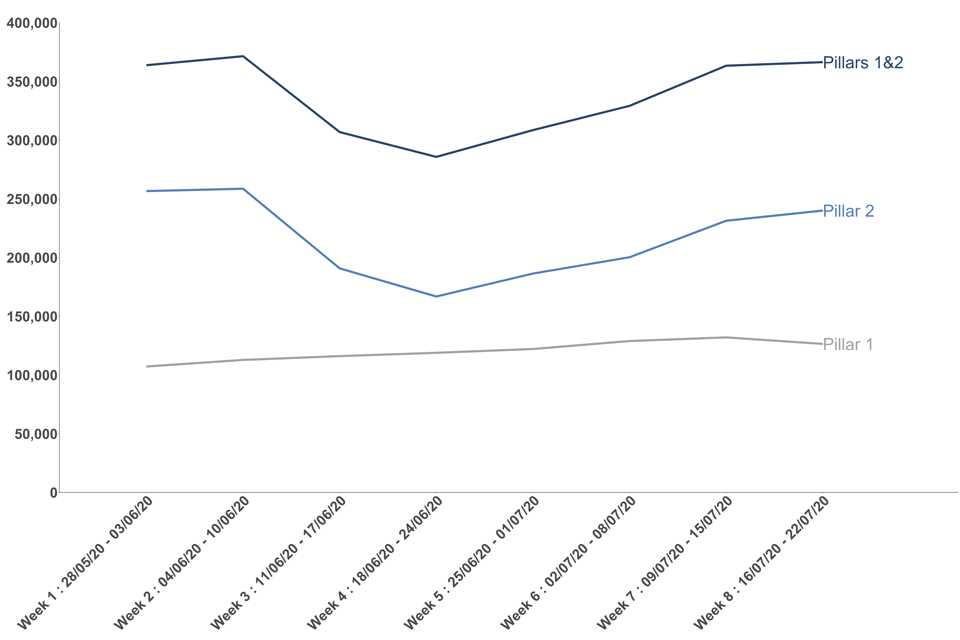
Chart is explained in the document text.
Figure 3: number of people newly testing positive for COVID-19 by pillar, England
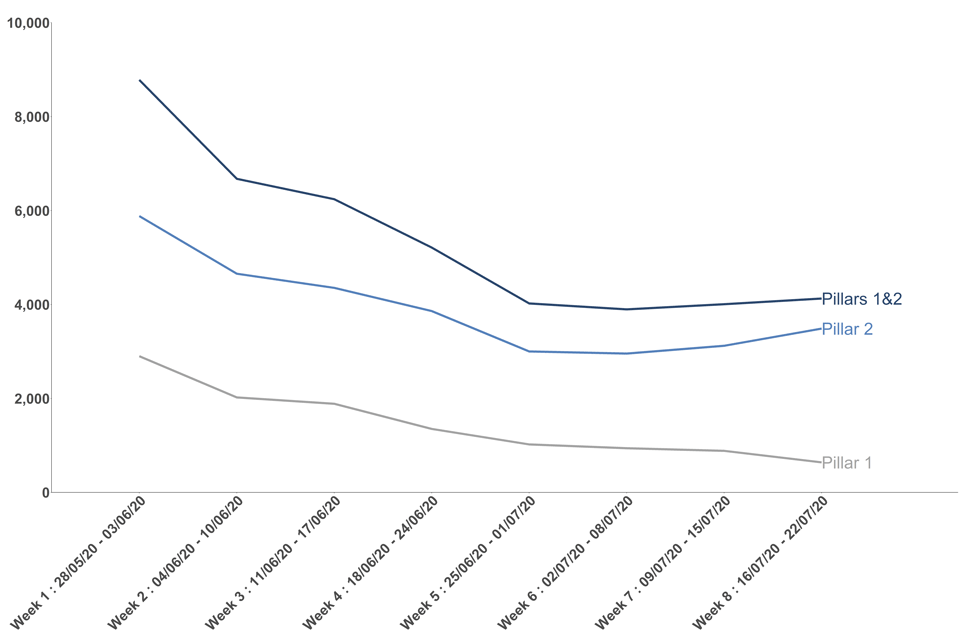
Chart is explained in the document text.
Table 1: people newly tested for COVID-19 under pillars 1 and 2, England
| 9 July to 15 July: number of people | 16 July to 22 July: number of people | Since Test and Trace launched. 28 May to 22 July: number of people | |
|---|---|---|---|
| Pillar 1 | 132,005 | 126,414 | 964,448 |
| Tested positive | 885 | 640 | 11,646 |
| Pillar 2 | 231,330 | 239,983 | 1,730,749 |
| Tested positive | 3,122 | 3,488 | 31,318 |
| Total | 363,335 | 366,397 | 2,695,197 |
| Tested positive | 4,007 | 4,128 | 42,964 |
When combined, pillar 1 and pillar 2 give the total number of confirmed cases of COVID-19 in the given time period and these people should all have had their cases transferred to the contact-tracing system.[footnote 5]
The number of positive cases transferred to the contact-tracing system may not always align with the number of people testing positive for COVID-19. There are several reasons for this:
- delays between a sample being taken, tested and reported, and being passed from PHE to the contact-tracing system mean that weekly totals transferred to NHS Test and Trace may include people who were tested in the previous week
- the number of people testing positive in pillar 1 may also include people tested anonymously and therefore will not have their case transferred to contact tracing
- there is not a rigorous process for de-duplication of the data being passed into the contact-tracing system each day, so some people may have their case transferred to the contact-tracing system more than once
More information is in the methodology document.
Note that these figures do not align with other published figures for people tested and people testing positive for COVID-19 under pillars 1 and 2. This is due to:
- differences in the date used for someone testing positive (this release uses the date the specimen was taken)
- differences in geography (this figure is for England rather than the UK)
More details on how our figures compare to other published figures is given in the methodology document.
Pillar 1 testing turnaround times
9 out of 10 pillar 1 test results were made available within 24 hours of the laboratory receiving the test
For pillar 1, the time taken to receive a coronavirus (COVID-19) test result is measured from the time that a test is received by a laboratory for processing to the time when the results are published to the Laboratory Information Management System (LIMS).
Most pillar 1 tests are conducted in a hospital setting, and it is therefore not practical for those administering the tests to record the exact time that a test was taken.
Table 2: time taken from receipt of the test by a laboratory to the time the result is published, pillar 1, 9 to 22 July
| 9 July to 15 July: number of tests (percentage) | 16 July to 22 July: number of tests (percentage) | Total since reporting began. 16 July to 22 July: number of tests (percentage) | |
|---|---|---|---|
| Total tests conducted in pillar 1 | 263,508 | 270,908 | 534,416 |
| Number of tests completed within 24 hours turnaround | 230,354 (87.4%) | 246,645 (91.0%) | 476,999 (89.3%) |
| Number of tests exceeding 24 hours turnaround | 33,154 (12.6%) | 24,263 (9.0%) | 57,417 (12.0%) |
There remain a small number of study samples and tests from private laboratories which are excluded from turnaround time figures as no timing data is available. Generally these tests make up less than 5% of the tests conducted and so their absence should not greatly affect the overall totals.
Pillar 2 testing turnaround times
For pillar 2, there are 2 measures of the time taken to receive a coronavirus (COVID-19) test result:
- the time taken to receive a COVID-19 test result from time of booking is measured from the time that a person books an appointment on the website to the time when the person receives a notification of their test result via an email or an SMS. This data is only available for regional test sites and mobile testing units, as test booking and registration processes for home testing and satellite test centres are currently undertaken on different systems
- the time taken to receive a COVID-19 test result from time of test is measured from the time a person completes a test registration (or the time a person indicates their test was taken for home testing kits) until the time that they receive a notification of the result of their test via an email or an SMS
After someone takes a test their test is transported to a laboratory for processing. There are normal fluctuations in this operational process which can sometimes cause the time taken to receive a test result to go over 24 hours, but still be turned around the next day. Where appropriate therefore we also provide the number of tests turned around the day after a test was taken.
For all measures of time taken to receive a COVID-19 test result, there are a number of tests that were not completed. This covers any test where the results were not communicated, which may be because communication details (for example, phone number or email address) were not provided or were incorrect, or because the test was cancelled or abandoned, or no result was available.
Data on the time taken to receive a COVID-19 test result is split up to show the different routes for getting tested (as listed on page 4), as this will have an impact upon the time taken. More details can be found in the methodology document.
Since 28 May when Test and Trace launched, the time taken to receive a test result after taking a test has improved (decreased) in pillar 2
The largest improvements (decrease in time taken) since week 1 of Test and Trace were for mobile testing units and home test kits. For in-person tests only (excluding both home tests and satellite tests), 76.4% of results from all test sites were received within 24 hours of a test being taken, in the same time period. If we consider the day the test was taken, this means 95.3% of in-person tests results were received the next day after the test was taken.
Compared to week 7 (9 July to 15 July), week 8 has seen an increase in the percentage of in-person tests returned within 24 hours and percentage of home test kit results returned within 48 hours. However, there has been a decrease in the percentage of tests from satellite test centres returned within 48 hours.
For all routes combined,[footnote 6] 50.6% of tests from all test sites were received within 24 hours of a test being taken in week 8. Excluding home-testing kits, this was 66.5% of all tests.
Figure 4: percentage of results received within 24 hours (in-person tests) or within 48 hours (home or satellite tests), by route,[footnote 7] England

Chart is explained in the document text.
Table 3: time from taking a test to receiving test results,[footnote 8] pillar 2 all routes, England
| 9 July to 15 July: number of people (percentage) | 16 July to 22 July: number of people (percentage) | Since Test and Trace launched. 28 May to 22 July: number of people (percentage) | |
|---|---|---|---|
| Within 24 hours | 131,950 (41.1%) | 160,179 (50.6%) | 742,541 (34.2%) |
| Between 24 and 48 hours | 145,042 (45.1%) | 123,889 (39.2%) | 1,000,447 (46.1%) |
| Between 48 and 72 hours | 35,083 (10.9%) | 24,793 (7.8%) | 327,829 (15.1%) |
| After 72 hours | 7,448 (2.3%) | 5,551 (1.8%) | 84,903 (3.9%) |
| Not completed | 1,737 (0.5%) | 1,935 (0.6%) | 14,173 (0.7%) |
| Total | 321,260 | 316,347 | 2,169,893 |
Regional test sites
In week 8, 73.8% of test results were received within 24 hours of the test being taken, compared to 68.8% in week 7. If we consider the day the test was taken, this means that 95.6% of tests results were received the next day after the test was taken. 98.3% of test results were received within 48 hours of booking a test.
Table 4a: time from taking a test to receiving test results, pillar 2 regional test sites, England
| 9 July to 15 July: number of people (percentage) | 16 July to 22 July: number of people (percentage) | Since Test and Trace launched. 28 May to 22 July: number of people (percentage) | |
|---|---|---|---|
| Within 24 hours | 72,601 (68.8%) | 88,135 (73.8%) | 426,653 (58.9%) |
| Between 24 and 48 hours | 31,830 (30.1%) | 29,785 (24.9%) | 280,354 (38.7%) |
| Between 48 and 72 hours | 236 (0.2%) | 497 (0.4%) | 8,607 (1.2%) |
| After 72 hours | 108 (0.1%) | 202 (0.2%) | 3,136 (0.4%) |
| Not completed | 826 (0.8%) | 839 (0.7%) | 5,930 (0.8%) |
| Total | 105,601 | 119,458 | 724,680 |
Mobile testing units
In week 8, 80.4% of test results were received within 24 hours of the test being taken, compared to 75.8% in week 7. If we consider the day the test was taken, this means that 94.9% of tests results were received the next day after the test was taken. 97.7% of test results were received within 48 hours of booking a test.
Table 4b: time from taking a test to receiving test results, pillar 2 mobile testing units, England
| 9 July to 15 July: number of people (percentage) | 16 July to 22 July: number of people (percentage) | Since Test and Trace launched. 28 May to 22 July: number of people (percentage) | |
|---|---|---|---|
| Within 24 hours | 49,932 (75.8%) | 62,118 (80.4%) | 232,612 (53.3%) |
| Between 24 and 48 hours | 14,942 (22.7%) | 13,601 (17.6%) | 184,486 (42.2%) |
| Between 48 and 72 hours | 254 (0.4%) | 513 (0.7%) | 10,788 (2.5%) |
| After 72 hours | 142 (0.2%) | 209 (0.3%) | 3,065 (0.7%) |
| Not completed | 579 (0.9%) | 778 (1.0%) | 5,759 (1.3%) |
| Total | 65,849 | 77,219 | 436,710 |
Satellite test centres
Satellite tests are predominantly used by care homes who need greater control and flexibility over when test kits are collected. For example, tests may be conducted over multiple days with a collection scheduled a few days later. Because of this a lower proportion of test results will be available within 24 hours of the test being taken. In week 8, 72.2% of test results were received within 48 hours of the test being taken, compared to 77.6% in week 7.
Table 4c: time from taking a test to receiving test results, pillar 2 satellite test centres,[footnote 9] England
| 9 July to 15 July: number of people (percentage) | 16 July to 22 July: number of people (percentage) | Since Test and Trace launched. 28 May to 22 July: number of people (percentage) | |
|---|---|---|---|
| Within 24 hours | 5,047 (8.1%) | 3,120 (9.2%) | 64,933 (14.7%) |
| Between 24 and 48 hours | 43,575 (69.6%) | 21,298 (62.9%) | 265,964 (60.2%) |
| Between 48 and 72 hours | 11,581 (18.5%) | 7,764 (22.9%) | 88,766 (20.1%) |
| After 72 hours | 2,171 (3.5%) | 1,503 (4.4%) | 20,584 (4.7%) |
| Not completed | 254 (0.4%) | 153 (0.5%) | 1,764 (0.4%) |
| Total | 62,628 | 33,838 | 442,011 |
Home testing kits
Home tests take time to be posted to a person and be couriered back to the lab. Because of this a low proportion of test results will be available within 24 hours of the test being taken. In week 8, 76.9% of test results were received within 48 hours of the test being taken, compared to 67.8% in week 7.
Table 4d: time from taking a test to receiving test results, pillar 2 home testing kits, England
| 9 July to 15 July: number of people (percentage) | 16 July to 22 July: number of people (percentage) | Since Test and Trace launched. 28 May to 22 July: number of people (percentage) | |
|---|---|---|---|
| Within 24 hours | 4,370 (5.0%) | 6,806 (7.9%) | 18,343 (3.2%) |
| Between 24 and 48 hours | 54,695 (62.7%) | 59,205 (69.0%) | 269,643 (47.6%) |
| Between 48 and 72 hours | 23,012 (26.4%) | 16,019 (18.7%) | 219,668 (38.8%) |
| After 72 hours | 5,027 (5.8%) | 3,637 (4.2%) | 58,118 (10.3%) |
| Not completed | 78 (0.1%) | 165 (0.2%) | 720 (0.1%) |
| Total | 87,182 | 85,832 | 566,492 |
Contact tracing
The number of people transferred to the contact-tracing system has decreased since Test and Trace was launched
In week 8 of contact tracing, 4,242 people were transferred to the contract-tracing system, an increase of 9% compared to the previous week. The number of cases transferred has seen an upward trend since week 6 but the number of people transferred is still 48% lower compared to when Test and Trace launched due to the reduction in people testing positive for coronavirus (COVID-19) over this period.
Figure 5: number of people transferred to the contact-tracing system (includes complex and non-complex cases), England
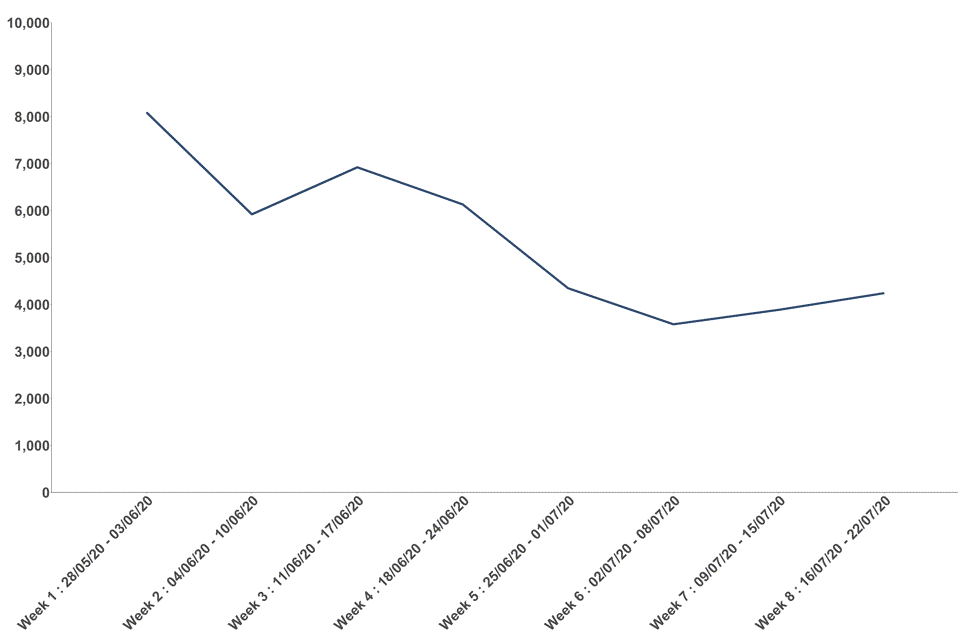
Chart is explained in the document text.
Table 5: people transferred to the contact tracing system (includes complex and non-complex cases) by whether they were reached and asked to provide contact details, England
| 9 July to 15 July: number of people (percentage) | 16 July to 22 July: number of people (percentage) | Since Test and Trace launched. 28 May to 22 July: number of people (percentage) | |
|---|---|---|---|
| People who were reached and asked to provide details of recent close contacts | 3,129 (80.5%) | 3,455 (81.4%) | 33,472 (77.6%) |
| People classified as non-complex | 2,880 | 3,253 | 27,871 |
| People classified as complex | 249 | 202 | 5,601 |
| People who were not reached | 582 (15.0%) | 665 (15.7%) | 8,228 (19.1%) |
| People whose communication details were not provided | 176 (4.5%) | 122 (2.9%) | 1,419 (3.3%) |
| Total | 3,887 | 4,242 | 43,119 |
In week 8 (16 July to 22 July) around 4 in every 5 people transferred to the contact-tracing system were reached and asked to provide information about their contacts
Out of the 4,242 people transferred to the contact-tracing system in week 8, 3,455 (81.4%) were reached, 665 (15.7%) were not reached and 122 (2.9%) had no communication details. These proportions have remained consistent since Test and Trace launched.
In week 8, 202 people, who were reached and asked to provide details of close contacts, were classified as complex cases. If NHS Test and Trace is not able to reach an individual testing positive or if no communication details are available, then it is not always possible to know if the case is complex or non-complex. Therefore, these breakdowns are not available.
After a person’s COVID-19 test is confirmed as positive, they will be transferred to the contact-tracing system to be contacted. The number of these people who were reached and provided details of recent close contacts includes complex cases investigated by local public health teams and people who said that they had no recent close contacts.
People who had no communication details provided are those who were transferred to NHS Test and Trace but did not have any associated contact details (for example, phone number or email address). This information is only available for non-complex cases handled through the contact-tracing system, as complex cases are handled by local public health teams and managed at a situational level.
The number of people who were not reached includes those people who the service has been unable to reach because there has been no response to text, email and call reminders. It also includes people who were reached but declined to give details of close contacts. There may also be a small number of people who have not been reached but where contact tracers are still in the process of trying to make contact.
Figure 6: outcome of people who were transferred to the contact-tracing system (includes complex and non-complex cases), England[footnote 10]
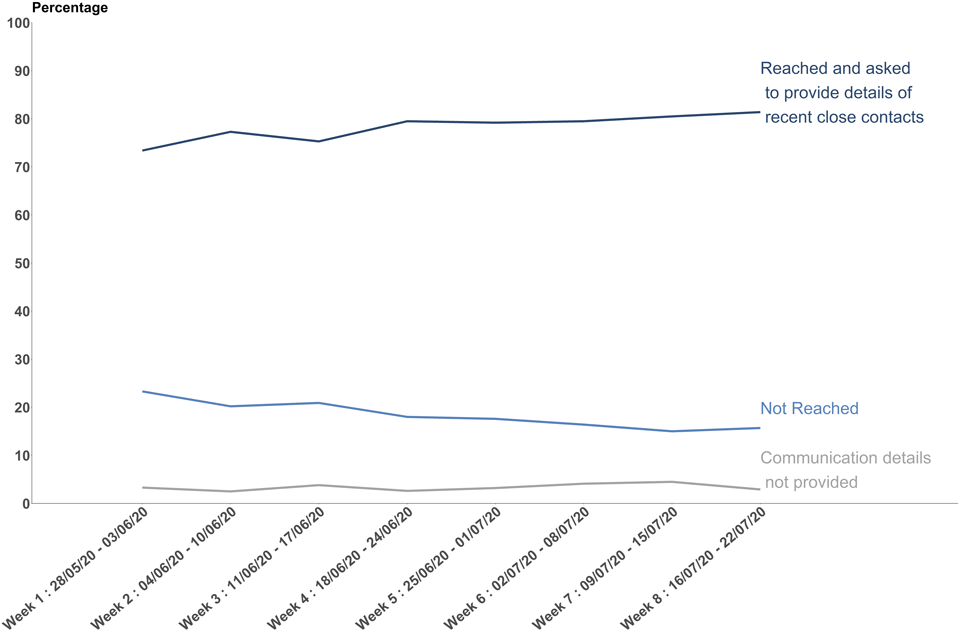
Chart is explained in the document text.
In week 8 (16 July to 22 July) around 4 in every 5 people who were reached and asked to provide information about their contacts provided one or more close contacts
Out of the 3,455 people reached in week 8, 2,809 (81.3%) provided details of one or more close contacts. There has been a gradual increase of the proportion of people providing details for one or more close contacts.
Not everyone who was reached and asked to provide details of recent close contacts will have had any recent close contacts. The number who were not able to give any recent close contacts therefore refers to people who were successfully reached by NHS Test and Trace, but could not provide details of close recent contacts to pass on for further contact tracing (for example, recent close contact with strangers on the bus).
Figure 7: proportion of people transferred to the contact-tracing system (includes complex and non-complex cases) who were reached and asked to provide details of recent close contacts by whether they provided details for contacts or not, England

Chart is explained in the document text.
Table 6: people transferred to the contact-tracing system (includes complex and non-complex cases) who were reached and asked to provide details of recent close contacts, by whether they provided details for contacts or not, England
| 9 July to 15 July: number of people (percentage) | 16 July to 22 July: number of people (percentage) | Since Test and Trace launched. 28 May to 22 July: number of people (percentage) | |
|---|---|---|---|
| People who provided details of one or more close contacts | 2,477 (79.2%) | 2,809 (81.3%) | 23,635 (70.6%) |
| People who were not able to give any recent close contacts | 652 (20.8%) | 646 (18.7%) | 9,837 (29.4%) |
| Total | 3,129 | 3,455 | 33,472 |
For non-complex cases, most people continued to be successfully reached and asked to provide details about recent close contacts within 24 hours of their case being transferred to contact tracing
In week 8, 2,373 (72.9%) of people were reached within 24 hours in comparison to 76.7% in week 7. Since Test and Trace launched, 18,073 (73.4%) of people have been reached within 24 hours.
Figure 8: proportion of people who were reached and asked to provide details about recent close contacts by time taken to reach them from case being transferred, England (excludes complex cases)
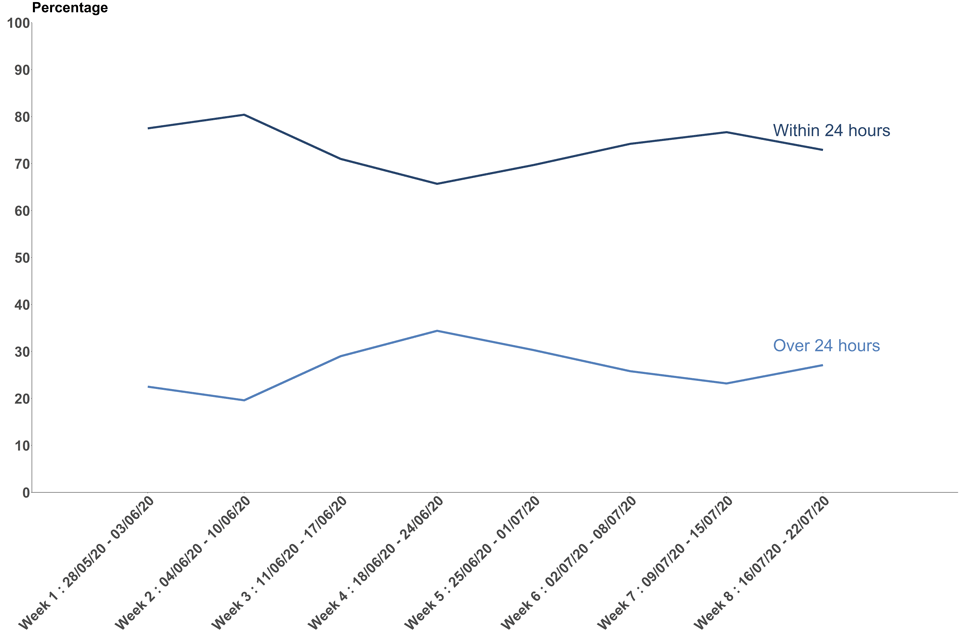
Chart is explained in the document text.
Table 7: people who were reached and asked to provide details about recent close contacts by time taken from case being transferred, England (excludes complex cases)
| 9 July to 15 July: number of people (percentage) | 16 July to 22 July: number of people (percentage) | Since Test and Trace launched. 28 May to 22 July: number of people (percentage) | |
|---|---|---|---|
| Within 24 hours | 2,210 (76.7%) | 2,373 (72.9%) | 20,438 (73.3%) |
| Between 24 and 48 hours | 515 (17.9%) | 668 (20.5%) | 5,051 (18.1%) |
| Between 48 and 72 hours | 99 (3.4%) | 142 (4.4%) | 1,224 (4.4%) |
| After 72 hours | 56 (1.9%) | 70 (2.2%) | 1,158 (4.2%) |
| Total | 2,880 | 3,253 | 27,871 |
The number of recent close contacts identified between 16 July and 22 July has fallen by 65% since the start of contact tracing but has increased by 8% compared to the previous week
Since the start of contact tracing the number of complex close contacts has fallen by 82%, whereas the number of non-complex close contacts has increased by 7%. When compared to week 7, the number of complex contacts has decreased slightly (down 1%) whereas the number of non-complex close contacts has increased by 17%.
As non-complex cases have a higher proportion of contacts who are unable to be reached, this has contributed to the reduction in the overall percentage of contacts who were reached and asked to self-isolate, from 90.8% in week 1 to 75.1% in week 8.
Figure 9: number of people identified as recent close contacts, England
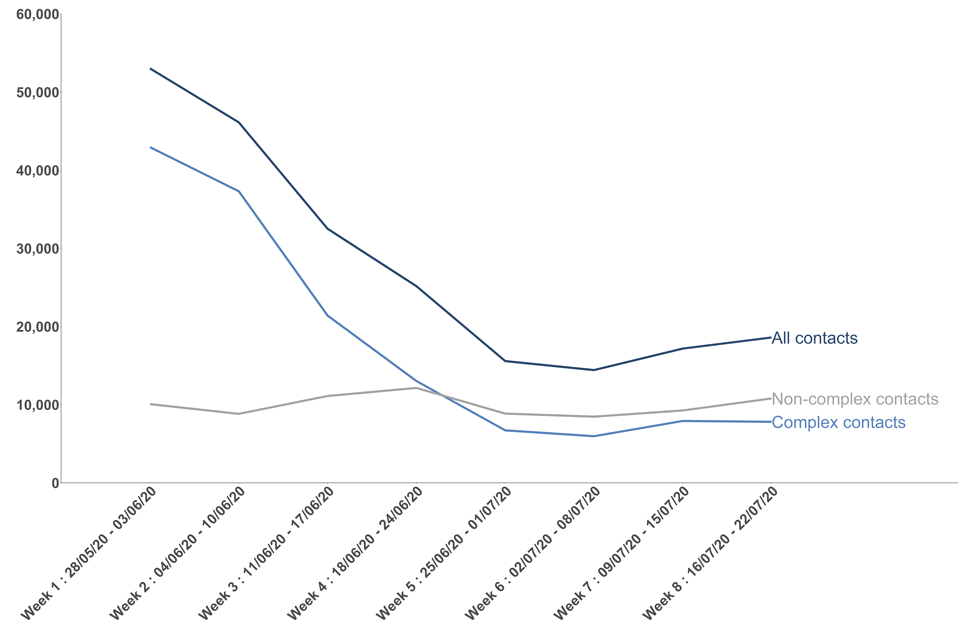
Chart is explained in the document text.
Table 8: number of people identified as recent close contacts by whether they were reached and asked to self-isolate, England (includes both complex and non-complex contacts)
| 9 July to 15 July: number of people (percentage) | 16 July to 22 July: number of people (percentage) | Since Test and Trace launched. 28 May to 22 July: number of people (percentage) | |
|---|---|---|---|
| Total number of close contacts identified | 17,175 | 18,598 | 222,589 |
| Close contacts reached and asked to self-isolate | 13,465 (78.4%) | 13,974 (75.1%) | 184,703 (83.0%) |
| Close contacts not reached | 3,710 (21.6%) | 4,624 (24.9%) | 37,886 (17.0%) |
The percentage of non-complex contacts who were reached and asked to self-isolate has increased to 60.9% since the start of Test and Trace
10,792 non-complex close contacts were identified of which 6,573 (60.9%) were reached and asked to self-isolate, 2,233 (20.7%) were not reached and 1,986 (18.4%) had no communication details.
The number who were not reached includes those people who the service has been unable to reach because there has been no response to text, email and call reminders, or those for which no contact details were provided to NHS Test and Trace (for example, phone number or email address). Further, there are some contacts who were reached but have not agreed to self-isolate.
Figure 10: outcome of contact tracing for recent close contacts classified as non-complex, England
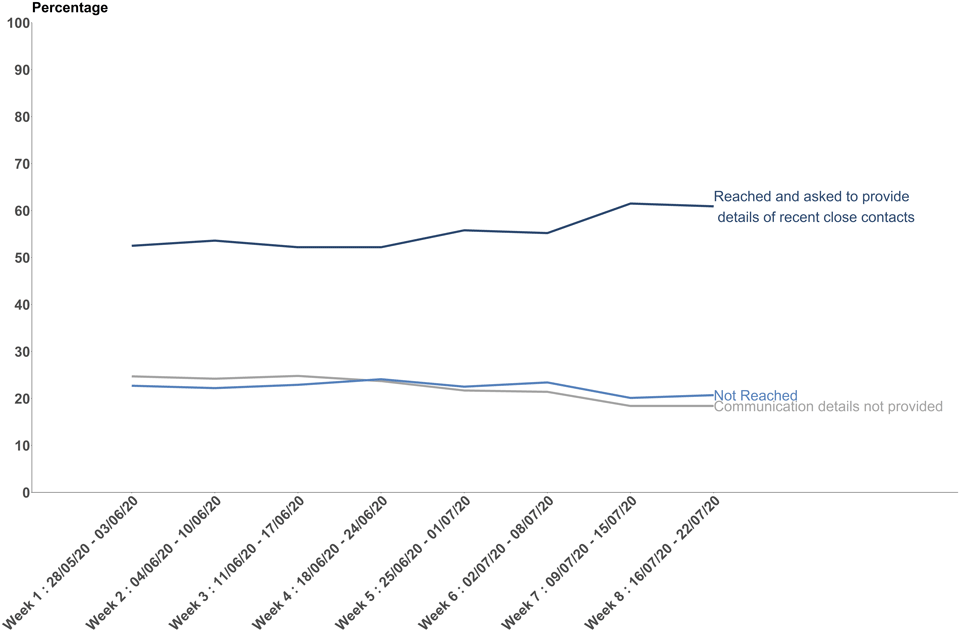
Chart is explained in the document text.
Table 9: number of people identified as recent non-complex close contacts, England
| 9 July to 15 July: number of people (percentage) | 16 July to 22 July: number of people (percentage) | Since Test and Trace launched. 28 May to 22 July: number of people (percentage) | |
|---|---|---|---|
| Total number of non-complex close contacts | 9,258 | 10,792 | 79,506 |
| Close contacts reached and asked to self-isolate | 5,697 (61.5%) | 6,573 (60.9%) | 44,043 (55.4%) |
| Close contacts not reached | 1,860 (20.1%) | 2,233 (20.7%) | 17,780 (22.4%) |
| Communication details not provided | 1,701 (18.4%) | 1,986 (18.4%) | 17,683 (22.2%) |
In week 8, around 6 out of 10 non-complex contacts were from the same household as the case they were identified from
The proportion of recent close non-complex contacts from the same household as the case they were identified from has been steadily declining since Test and Trace launched. In week 8, 63.2% of non-complex contacts were household contacts compared to 69.0% in week 7.
Almost 6 out of 10 of these household contacts were successfully reached and asked to self-isolate. This is in comparison to almost 7 out of 10 for non-complex contacts who were from a different household to the case from which they were identified. Contact tracers will often ask cases themselves to advise their household members to self-isolate without the need for contact tracers to contact them individually. This results in these contacts not being recorded as reached and asked to self-isolate, which is likely a contributing factor for a lower proportion of household contacts being reached in comparison to non-household contacts.
Figure 11: proportion of recent close non-complex contacts by whether they were from the same household as the case that they were identified from, England

Chart is explained in the document text.
Table 10: number of recent close non-complex contacts by whether they were from the same household as the case that they were identified from, England
| 9 July to 15 July: number of people (percentage) | 16 July to 22 July: number of people (percentage) | Since Test and Trace launched. 28 May to 22 July: number of people (percentage) | |
|---|---|---|---|
| Total number non-complex household contacts | 6,392 | 6,818 | 56,556 |
| Close contacts reached and asked to self-isolate | 3,657 (57.2%) | 3,872 (56.8%) | 29,647 (52.4%) |
| Close contacts not reached | 2,735 (42.8%) | 2,946 (43.2%) | 26,909 (47.6%) |
| Total number non-complex not household contacts | 2,866 | 3,974 | 22,950 |
| Close contacts reached and asked to self-isolate | 2,040 (71.2%) | 2,701 (68.0%) | 14,396 (62.7%) |
| Close contacts not reached | 826 (28.8%) | 1,273 (32.0%) | 8,554 (37.3%) |
For non-complex contacts who were advised to self-isolate, more than 4 out of 5 of them were reached within 24 hours of being identified[footnote 11]
In week 8, 81.7% of non-complex contacts that were advised to self-isolate were reached within 24 hours of being identified. This has remained consistent since Test and Trace launched with 83.1% of all non-complex contacts advised to self-isolate being reached within 24 hours.
Figure 12: proportion of recent close contacts who were advised to self-isolate by time taken to reach them, England (excludes complex contacts)
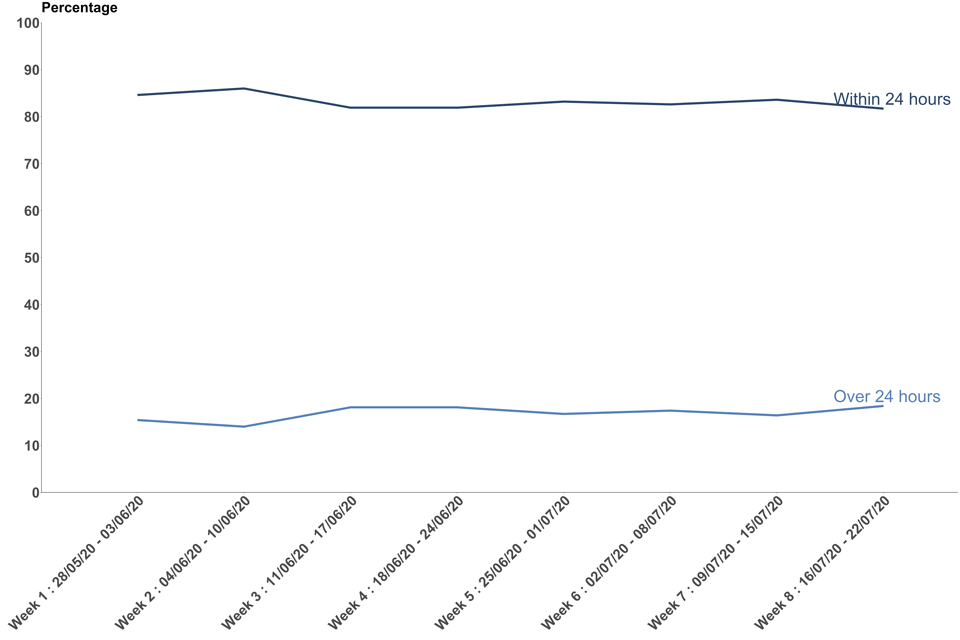
Chart is explained in the document text.
Table 11: people identified as recent close contacts who were advised to self-isolate by time taken to reach them England (excludes complex contacts)
| 9 July to 15 July: number of people (percentage) | 16 July to 22 July: number of people (percentage) | Since Test and Trace launched. 28 May to 22 July: number of people (percentage) | |
|---|---|---|---|
| Within 24 hours | 4,761 (83.6%) | 5,365 (81.7%) | 36,539 (83.1%) |
| Between 24 and 48 hours | 787 (13.8%) | 956 (14.6%) | 5,686 (12.9%) |
| Between 48 and 72 hours | 98 (1.7%) | 195 (3.0%) | 1,119 (2.5%) |
| After 72 hours | 49 (0.9%) | 54 (0.8%) | 637 (1.4%) |
| Total | 5,695 | 6,570 | 43,981 |
For non-complex contacts who were advised to self-isolate, over half were reached within 24 hours of the case that reported them being transferred to the contact-tracing system
In week 8, 54.7% of non-complex contacts who were advised to self-isolate were reached within 24 hours of the case. For all non-complex contacts who were advised to self-isolate since Test and Trace launched, 55.1% have been reached within 24 hours.
This measure gives a sense of the end-to-end journey time through the Test and Trace system from when an individual testing positive was reported to Test and Trace, to when their close contacts were reached and advised to self-isolate. This information is only available for non-complex contacts, although there are a small number of non-complex contacts where the time taken from the time that a positive case is transferred is not available.
Figure 13: proportion of recent close contacts who were advised to self-isolate by time taken from the case that reports them being transferred to the contact-tracing system, England (excludes complex contacts)

Chart is explained in the document text.
Table 12: number of close contacts who were advised to self-isolate by time taken from the case that reports them being transferred to the contact-tracing system England (excludes complex contacts)
| 9 July to 15 July: number of people (percentage) | 16 July to 22 July: number of people (percentage) | Since Test and Trace launched. 28 May to 22 July: number of people (percentage) | |
|---|---|---|---|
| Within 24 hours | 3,179 (55.9%) | 3,506 (54.7%) | 24,073 (55.1%) |
| Between 24 and 48 hours | 1,726 (30.3%) | 1,929 (30.1%) | 12,251 (28.0%) |
| Between 48 and 72 hours | 537 (9.4%) | 663 (10.4%) | 4,328 (9.9%) |
| After 72 hours | 246 (4.3%) | 306 (4.8%) | 3,037 (7.0%) |
| Total | 5,688 | 6,404 | 43,689 |
Almost all complex contacts continue to be reached and asked to self-isolate
7,806 complex close contacts were identified of which 7,401 (94.8%) were reached and asked to self-isolate, 405 (5.2%) were not reached.
Figure 14: outcome of contact tracing for recent close contacts classified as complex, England

Chart is explained in the document text.
Table 13: number of people identified as recent complex close contacts, England
| 9 July to 15 July: number of people (percentage) | 16 July to 22 July: number of people (percentage) | Since Test and Trace launched. 28 May to 22 July: number of people (percentage) | |
|---|---|---|---|
| Total number of close contacts identified from complex cases | 7,917 | 7,806 | 143,083 |
| Close contacts reached and asked to self-isolate | 7,768 (98.1%) | 7,401 (94.8%) | 140,660 (98.3%) |
| Close contacts not reached | 149 (1.9%) | 405 (5.2%) | 2,423 (1.7%) |
Measuring the data
How the data were collected
These data are collected from management information from the NHS Test and Trace service. More details about the methodology used can be found in the methodology document.
Future development
We have integrated these data with those from other parts of NHS Test and Trace, particularly testing, to provide an end-to-end view of the service that follows the user journey. So far, testing data for pillars 1 and 2 and the testing turnaround times have been added. Further breakdowns for contact tracing continue to be incorporated, including complex and non-complex breakdowns and household information. To support user needs and data transparency, additional releases have been published alongside the weekly Test and Trace publication including care home statistics up to 8 July and people tested for coronavirus (COVID-19) between 30 January and 27 May. NHS Test and Trace continues to provide information for local authorities and their partners so that they have the information they need to help contain any outbreaks.
In time, NHS Test and Trace intends to publish detailed data from across the programme to support secondary analysis, for example in academic institutions. Over the coming months, we intend to make the following available:
Expected July to August 2020:
- regional breakdowns for tracing data
- characteristics for those tested under pillar 2
- high-level UK test and trace figures
Expected from September 2020:
- details of close contacts who go on to test positive
The UK Statistical Authority has published a rapid review of the Test and Trace statistics. This includes recommendations on how the publication should develop it order to adhere fully to the Code of Practice. These recommendations continue to influence the development of the publication in the coming weeks and months.
Quality
These statistics have been put together by NHS Test and Trace with advice from the Office for National Statistics.
More information on quality and how this publication adheres to the Code of Practice for statistics is available in the statement of compliance.
Strengths and limitations
Given the importance of this service and the commitment of NHS Test and Trace to be open and transparent with the public it serves, these data are being released at the earliest possible opportunity.
However, new IT systems and statistical outputs often take a period of time to bed in. These data should therefore be treated with caution as the system and understanding of the data develops.
The figures presented are based on a data cut several days after the end of the reporting period, to give time for test results and cases reported at the end of the 7-day period to have an outcome. Some cases and test results may continue to be in progress after this period, and therefore data may need to be revised over time.
Feedback
For questions about the release please refer to the information for users document initially. For feedback and any further questions, please contact statistics@dhsc.gov.uk.
-
This excludes people who have previously been tested in a prior week. See the methodology document for more details. ↩
-
Some people may have had their case transferred to the contact-tracing system more than once. Currently, there is not a rigorous process for de-duplication of the data being passed into the contact-tracing system each day, as the emphasis is on transferring these cases quickly. Therefore, there may be more people transferred to contact tracing than test positive for coronavirus within a given period. ↩
-
May include a small number of people who had a test under pillar 4 (serology and swab testing for national surveillance). People tested under pillar 3 (serology testing to show if people have antibodies from having had COVID-19) do not have their cases transferred to NHS Test and Trace. ↩
-
See more detail in Scaling up our testing programmes. ↩
-
Figures for people testing positive have been de-duplicated so people who have multiple tests in both pillars 1 and 2 would only appear once. The number of people testing positive in pillar 1 may also include people tested anonymously as part of surveillance studies, and therefore will not have their case transferred to contact tracing. ↩
-
All routes includes regional test sites, local test sites, mobile testing units, satellite test centres and home test kits. ↩
-
In-person tests are those from regional test sites and mobile testing units. Home or satellite tests are those from satellite test centres and home testing kits. ↩
-
Please note the number of people receiving results within a given time is not the same as the number of people tested, because people may be tested more than once. ↩
-
This data does not include Randox tests, as these are handled through a different system. Randox tests make up a significant proportion of the tests conducted in care homes, which form part of the satellite test centres. ↩
-
Data has been split to show those cases whose communication details were not provided. Previous publication included cases where communication details not provided under ‘Not reached and asked to provide contact details’. Numbers have been revised for previous weeks to account for new methodology. ↩
-
Timing data does not include non-complex contacts which were subsequently escalated to complex. ↩
